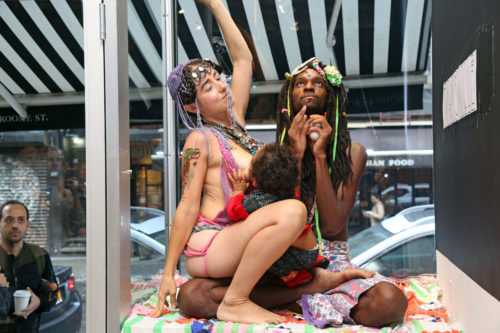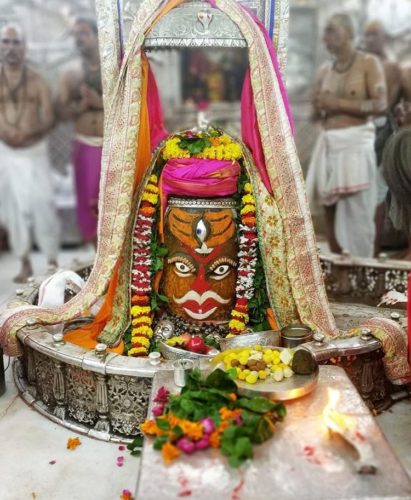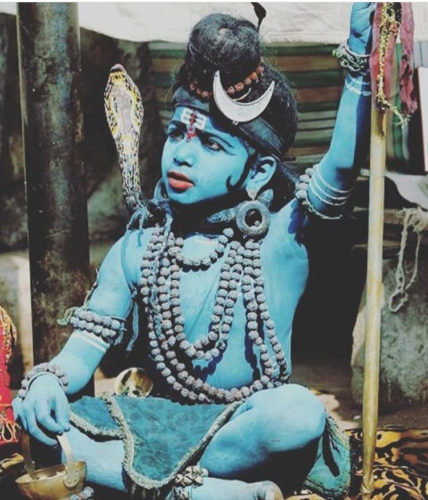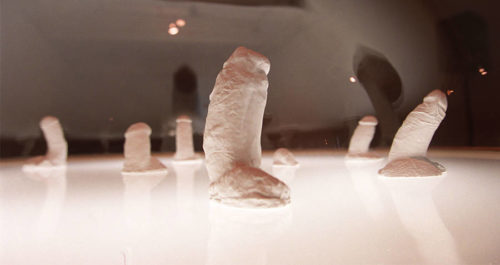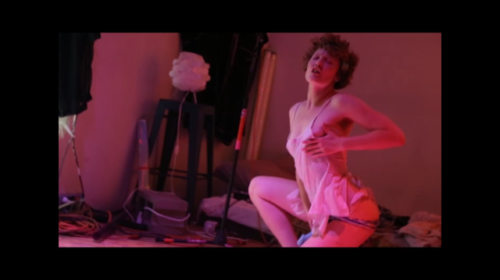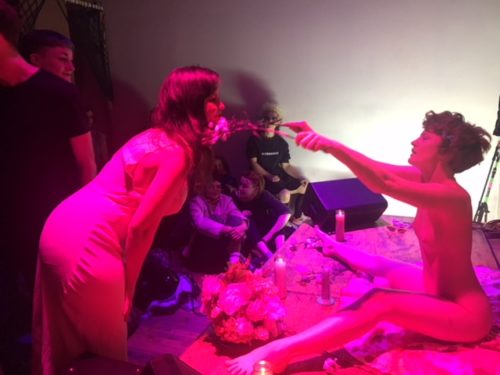By KATIE CERCONE
“The Last Taboo Is the Penis,” white male dealer John Cheim, one half of Cheim & Read, announced to the art world in 2016 when he organized the group exhibition “The Female Gaze, Part II: Women Looking at Men,” which boasted works by some of the art world’s cockiest women, including Linda Benglis, Tracey Emin, Diane Arbus, and Jenny Holzer 1. Cheim put together the show featuring women who are dealing with the last taboo of the penis in “a very direct and transgressive way.” I’m not sure if I would have had so much empathy for Cheim’s plea back in 2016, although I adore all of those artists. Having burned the candle on both ends to make a career as a feminist artist in New York City against all odds for over a decade, I certainly wasn’t one to have much sympathy for rich white men. With intersectional Feminism still very much on the rise (occasionally to its own detriment); add to that all the hashtag feminists and #MeToo folks… there’s a whole lot of us at the table right now coming to criminalize, demonize, call out and shame men (and their penises) for bad behavior. We want to eat, too. If you’re in the movement for change — contributing to women’s, non-white persons and gender non-conformer’s pleasure and power with good intentions (not just for personal gain or because someone else is a convenient target for your own repressed rage) — keep it up. The more we collectively speak out about the abuses of power and educate each other about what’s possible, the more we heal society as a whole. I believe there’s a bunch more fires that need to erupt and whistles that will blow hard before we can even begin to make sense of how to fully decolonize, repair and heal.
Several years ago in Bushwick, I overtook the whole living room as my studio and covered one corner ornately with gleaming fabrics, bric-a-brac and all sort of glittering detritus. Around that period I happened to see the feminist/queer folklorist Kay Turner speak at the women’s coop gallery A.I.R. in Dumbo. During her lecture, it was like a light bulb went on. I realized the looming installation in my living room was an altar to my vulva. Later through Turner’s Book Beautiful Necessity: The Art and Meaning of Women’s Altars, I rethought why and how my Grandmother had been apparently brain-washed by the patriarchy to blindly worship the sexless, neutered Mother Mary that was seemingly disempowering her on multiple levels. Backstory: she refused to take birth control siding against social workers and with her faith, raising 8 children she didn’t quite want but felt it was her duty to Mother, in turn sacrificing her own health and sanity, perhaps. By the time my Mom was born (into neglect), all my Grandmother could do was prop up a bottle of Nestle formula with a straw. Because her religion had leached most of the magic out of its women long ago and left out the part of the sermon that tells us the first sacrament was breastmilk. But in fact, somewhere within and between her church life, my Grandmother’s (also named Mary) devotion to Mother Mary evidenced a much deeper and longer lineage celebrating a Female God figure/Divine Feminine origin. In exploring Kay Turner’s writing relating her 20 years of research conducted on women from cultures the world over building personal, ritual shrines in their home (often as a way of reclaiming their agency in the midst of damning, patriarchal religious climates, many to Mother Mary) I was able to restore some dignity to my ancestors within my own contemporary Feminist lens. That tangent is to say — been there, done that. I’m not a neutral witness to this whole mess, nor do I claim to be objective or fully at peace.
Viva la zines, altars, rituals, mantras, sit-ins, speak-outs, eat-outs, blood magic, sex magic (reader beware) — if you’re lucky this all becomes part of your happy, healthy, holy routine. You pass it on from sister to sister and support each wombyn on her own unique, personal and culturally-specific journey. There’s much, much more to pussy power than just mind-blowing orgasms and zipless fucks or whatever slang is for “Independent Woman” these days. Women can also make and carry life. But you need real dick for that. My current partner and I always laugh about how his first girlfriend had a huge private chest of dildos and one day abruptly moved to India running after her new guru (that’s the way I remember the story at least). Thus, our contemporary tale begins. Where modern feminism meets sexuality and mutuality, where the yoni opens unto the Yoniverse. The next step in weeding my garden was to locate a positive pedagogy of the penis. Call it taboo, or call it boo (affectionately), thus begins my defense of the Linga.
Linga, also known as Lingam or jyortirlinga. As we’ve noted, feminists have been reclaiming their sacred most inner temples, celebrating their pleasure and intergalactic pussy power, but what about the other half? Do I really want my son growing up thinking men are perverts, rapists, power-mongers, killers and at the very least insensitive jerks? If my pussy is heaven, then there must be the male equivalent. And I’m not talking the phallic mega towers piercing the sky or the circle jerks and popsicles corrupting my pleasures of youth. Strip away all the conditioning on both sides. Bypass the “sacred” Fathers running free to molest our children and the misogynistic porn mega-complex seeping into Hollywood, Politics and video games for young boys; add to that the loads of dude bros you know or have accidentally dated. It’s time to establish a model of masculinity we can be proud of, we can love, and we can enjoy. As a yogi on the path for twenty years, Yoga being a ritual art and science that often dovetails with my creative practice, my anchor into a positive male sexuality began with Tantra. Yogic Sex. The God of Power and Ecstasy — “Shiva” who’s penis we call Lingam. Penis, mind you, is as poor a translation for “linga” as “vagina” is for the Sanskrit “yoni” but we open our inquiry where we are. Enter the Linga, at once flaming fire, cooling water, cosmic song, healing elixir, and endless ray of light.
Hindu Sanskrit is not a regular language we can compare to English… its words are sacred utterances, designated for the esoteric realms of ritual alchemy, the purifying pathways and chill mind grooves of the Yogini. Each letter of the Sanskrit alphabet, Hindu “language of the gods,” defines the innermost meaning of the word. Yoni, (pronounced yo-nee) carries the total meaning Y = The animating principle, the heart, the true self, union; O = Preservation, brightness; N = Lotus, Motherhood, menstrual cycle, nakedness, emptiness, pearl; I = Love, desire, consciousness; to shine, to pervade; pain and sorrow. “Linga,” the male principle we can match with Yoni, connected to but not limited to male anatomy, is the overarching spiritual metaphor anchoring my defense of the divine Masculine in this essay. Herein I set out to share some insight from my research into its richly arousing mythology, embellishing with some fun corollaries to other important contemporary feminist artists who have made their mark with Cock.
The Linga as an emblem emerged in my creative practice when my partner and I delivered a performative hip hop yoga lecture called “Shiva’s Linga,” during Coco Dolle’s art salon Transville November 2017 at Catinca Tabacaru gallery. Most of the research I did for this performance piece is recounted here, and you can listen to parts of the lecture in the edited performance video below. Imagine me pouring an offering of liquid Shakti on my Man’s Lingam while rapping “Karma Sutra for Breakfast Bitch” (angrily) to the small Lower East Side gallery space stuffed with art world folks, their jaws slackened by my family’s peep show, my 18-month-old son Kali sucking the life hungrily out of my nipple. Shiva, the Creator/Destroyer God dancing on the breast of Hindu alterity, had been lingering in my imaginary for some time. In fact, it was Coco who first suggested that my work with the queer feminist collective Go! Push Pops was resurrecting a “Neon Pop Shiva” archetype. Lord of the Dance, Shiva is counterpart to Kali Ma (Goddess figure most appropriated by the Western Feminist camp for her legendary reputation as a bloodthirsty Black Warrior Mother). Crazed beggar, savior, necrophiliac, voluptuary, ascetic — Shiva is very much on the transgressive border of culture, at the same time, he is Sadasiva, the eternal Siva who transcends everything. The Linga is to the yoni what Kali is to Shiva: ground, base and animating principle. The linga in fact emerges from the yoni; it does not penetrate it as we would think in the Western sense of the phallic. “The composite shape of yoni and linga is an epistemological symbol set up for worship,” writes Stella Kramrisch 2. Another interesting fixture of the Shiva/Shakti Yoni/Lingam pair is, as we mined semi-consciously as the transnational feminist queer collective Go! Push Pops, Shiva is The Lord who is half woman and half man. He is the Archetypal queer Rockstar.
A Third millennium B.C. Harapaan seal features a hermaphrodite figure seated in Lotus, his feet crossed below an erect urdhva-linga. Buffalo horns decorate his headgear and four animals flank the central seated Lord. This depiction of Shiva (before he was Shiva) dates 2,000 years proceeding “yoga” and the famous 2nd century B.C. Yoga Sutras of Patanjali. Rounded breasts signify the feminine aspect, while the penis pointing upwards shows that the “God has controlled sex.” That is to say, his semen is held or absorbed within his body representing mastery over the sexual urge. Yogically speaking, in the words of scholar Stella Kramrisch, “Sex is the field of the fiery ardor of asceticism.” Refraining from worldly pleasure to reserve strength in yogic austerities is paradoxically sustained by the power of sex, which it consumes and transforms. Within yogic science, the human being (not some distant God figure) serves as the reservoir of metaphysical realization. Later on, this Lord of Yogis archetype would be further codified in its half male, half female form we know today as Shiva Ardhanarisvara. As Stella Kramrisch so beautifully details writing about India’s sacred art, “Animal power and sex-controlled by yoga are coalesced in a pattern that renders the enigmatic likeness of the god”3.
Today, with the (Western) “Rockstar” having largely eclipsed the macrocosmic role Gods played within ancient societies, the imprint of archetypes long past still guide us to seek out spectral love. And in our superbly post-religious, post-modern, poster-boy carnivalesque consumption ball the internet and the phantom limbs of white male patriarchal capitalism have certainly created widgets on widgets to capitalize on our human need for faith. And yet, today’s cosmopolitans are indeed still citizens of the cosmos. As modern Science has proven, we are still “star stuff” 4. Our pop culture is pregnant with mythical figures found in the brain — the vocabulary of the psyche itself — that which structures our emotional physical, social, and spiritual realities.
The Shiva “Lord of the Dreadlocks” archetype can be read in modernity’s megastars like Bob Marley. Speaking for surface aesthetics, his looks closely resemble a Shaivite (devotee of Shiva), distinguished by their matted hair and the glazed eyes of one who has sparked the ganja. Interesting that Rastafarians come from a part of Jamaica which is mainly populated by East Indians (trafficked there by British Colonialism). Rastas adopted the practice of smoking ganja from the Hindus in Jamaica, who smoked ganja to intone prayer to their Godhead Shiva and seek release from mortal coils. The Hindustani word “ganja” is derived from Sanskrit 5. Born much after the heyday of Marley, folks of my generation may have looked to figures such as Lil Wayne. American Hip Hop great Lil Wayne aka “Weezy” and his penchant for smoke, big booty bitches and rhymed mantras; his flowing dreadlocked hair “spiritual antennae” reaching up to the cosmos certainly has inspired in the masses a type of neo-spiritual frenzy. I conveniently wrote my Masters thesis on Lil Wayne in Art School while at SVA. Rappers like Lil Wayne coined the language that defines my generation’s relationship to sexuality. From the luscious linga-inspired “I say he so sweet make her wanna’ lick the rapper / So I let her lick the rapper / Sh, sh, she lick me like a lollipop” (Lollipop, 2008, Tha Carter III) to his RnB infused power-ballad “Make it Rain” (2007), which refers to both female ejaculation (Liquid Shakti’s healing waters par excellence) and when one throws up a wad of cash in the air in a strip club making it rain money. If spiritual leaders do as they say “Speak in Sexual Metaphors,” we can also applaud Lil Wayne for also speaking out about the childhood sexual abuse he suffered growing up in the Dirty South. Called “The Spirituality of Hip Hop,” my early writing on the subject seeded the hip hop yoga project I have been pioneering these past couple of years with my partner UNDAKOVA at our ULTRACULTURAL OTHERS Urban Mystery Skool in NYC. Sounds wild, I know.
Indeed the most sacred work of the Hindu religious imagination, about Lord Shiva, begins “a poem about the wild god” (4). Many scholars have associated Shiva with ecstasy, intoxicants, and sexuality. We might find his Eurocentric counterpart in the Olympian God Dionysus, who supposedly teased the Amazon women out of angry bloodlust at the barbarous peak of Matriarchal rule. Just as Warrior Goddess Kali’s killing spree came to a halt when she noticed her lover, Lord Shiva, was sleeping beneath her feet on the battle field (about to be her next victim), Dionysius ushered in a new period in which women made a sweet surrender via wine, dance and the orgiastic splendors. All that and more was to be had in the company of this youthful and effeminate God of wine, fertility, and ritual madness. Dionysus is in turn linked to Jesus, whose early followers of Christianity engaged in similar forms of embodied ritual ecstasy. Personally, in my adolescent devotion to Lil Wayne I sought out a modern, positive masculine anchored in primal male sexuality; unfortunately, it’s one that is also kept at bay by the marginal role of black males in American society. The heightening of the stereotypically hyper sexual, hard, violent and damaged black male within the music industry is intentional, rippling out culturally to necessitate the prison-industrial complex as neo-slavery, meanwhile the shackles of the music industry’s exploitative top-down corporate racket mainly benefits the white male power structure. This “spectral Love” for the faraway male on the stage or in the screen is also a way in which women experience a removed love for the masculine that can be pathologically obsessive, fixed in paralyzed fantasy, and in this sense both disembodied and disempowered.
An interesting parallel here is perhaps the handful of “Heavenly Bridegrooms” of the 20th century, females that claimed to make love with Angels, most notorious of them being a woman by the name of Ida Craddock, sex mystic and martyr who at one point proclaimed herself “Priestess and Pastor of the Church of Yoga” 6. I also feel inclined here to mention Cynthia Plaster Caster, who many know as the artist who spent decades of her life courting legendary rock stars only to make plaster molds of their penises. Having cast over 48 famous rock star penises since 1968 — when she began the process utilizing a martini shaker filled with dental mold gel — molds in her collection include Jimi Hendrix, whom Cynthia names as her favorite musician to cast 7. Cynthia’s collection has been shown at PS1 in recent years and for me, represents a volatile threshold in which art can serve as a catalyst toward moving us through certain dysfunctions transmuting stuck energy by upheaval, humor and excessive attention to a particular subject matter. Today’s culture of lethargic spectacle and consumption (forgetting we are star stuff and projecting our power into screens) certainly traces back to religious institutions that took the real potency embodied in the spiritual away from the masses and poisoned many generations instinctive primal sexuality with the toxic emotions of shame and guilt.
Just as many today are reclaiming their lost roots practicing yoga, tantric sex, taking mushrooms or ayahuasca or other mind-expanding plant medicines in contemporary ritual ways, a long tradition of shamanic yoga practice is embedded in Shiva’s form and function that we can mine for gold. Shiva’s also coincidentally linked in Vedic astrology to the Star Sirius “hound of heaven,” (Shiva as Rudra “The Archer” is the same star); Sirius being an important spot on the map of African Diasporic consciousness. It is often linked to the Dogon ethnic group of West Africa, who’s vibrant ritual culture, left miraculously intact through the centuries, involves orienting farming practices around the orbit of the star as well as various ancient legends that tell their people came to Africa from the Star Sirius long ago. Given the profundity of sacred knowledge about the earth, agriculture, healing and total mind-body health in Yoga and Ayurveda, it makes perfect sense to link Shiva, The Archer of Microcosmic Integrity with Sirius and a modern lexicon of Afro-Futurism which ensures that community identity, memory, history and environmental sustainability are formed in conscious relationship to the Land and Sky.
For Yogis, Shiva is wrapped up in the paradox of the veil of maya (illusion), one that continually reveals and obscures the truth of existence. Recall John Cheim calling the penis the Art World’s last taboo, saying, “It’s very shrouded and guarded.” As Shiva dances through death, time and change into eternity, he personifies the human body which is half fire, like the sun, flame, and lightening; and half soma, like the moon; but is also half male, half female. When we practice yoga, we begin to embody this dual shiva/shakti inner divinity aspect. In layman’s terms, balancing your masculine and feminine energy is the building blocks of enlightenment. The science of alternate nostril breathing, for instance, a common pranayama one can easily learn in a beginner’s yoga class, has the purpose of balancing Left/Right hemispheres of the Brain and Shiva-Shakti synchronicity. It also offers a mysterious key into the currents of our Pranic Life force energy, thought processes and moods. Throughout the day, one nostril is always dominant, just as one brain hemisphere is always dominant. Nostrils alternate every two hours, in relationship to the sun, moon and planetary activity. Our right nostril, which is masculine (solar), is connected to solar planets — the Sun, Mars and Saturn. Every Sunday, Tuesday and Saturday the right nostril works with the ruling planet of the day for one hour. Same goes for our left (feminine) nostril, connected to the Moon (Monday), Mercury (Wednesday), Jupiter (Thursday) and Venus (Friday). The ascending moon cycle starts the night of the New Moon, when at dawn, the left nostril dominates for three days. Emotional Labor is a left nostril job; physical labor a right nostril one, and the long list of activities and aspects associated with our sides is exhaustive. Sushumna — when both nostrils work together (and the goal of alternate nostril breathing) — happens at dawn when the nostril of the planet ends and the next nostril takes over. Sushumna is the optimal time for yoga and meditation, which is why yogis practice traditionally at dawn 8
.
Shiva’s Linga is very much the ascending column in which he dissolves into samadhi, in which he meditates. It is the shape in which he dwells invisible. Both ascetic and the erotic aspects unite in the symbol of Shiva’s linga. He haunts, grips and liberates. Shiva is “all anxieties, diseases, and the destroyer of diseases, and disease itself” 9. With a thousand eyes, his body is the fire of yoga. From his embodiment as the Wild Archer Rudra, shooting his star rays out into the ordered field of power, as its numinous gatekeeper, arose Shiva as Vastopati, “guardian of the order of the cosmos.” In this sense, Shiva is the originator of all Arts and Architect of the Universe 10.
In another version of his myths, Shiva became enraged and tore out his own phallus. As his Linga fell to the earth, he “diffused his splendor into the plants and healing herbs for all creatures,” which is why we associate Shiva with healing medicines such as herbs, grasses and mushrooms11 as well as all of India’s divine waters. Springs, streams, and wells channel the manifest energy of creation (Shakti) to the linga of Shiva. India’s primary river, The Ganges, called affectionately “Ma Ganges” in the unique Hindu way of inscribing myth on Earth, is “giver of release” and “giver of joy.” Liquid shakti of the Lord, she floats down from heaven (and the Highest Himalayan Mountains) into his dreadlocks as they spread through the cosmos during Shiva’s dance of ecstasy. Her foam caresses his hair, her hands reach out to the crescent moon there at his crown 12.
Shiva is of course linked to the serpent or Ouroboros (snake biting its own tail) — the yogic seal of regeneration. The serpents who shed their skins in a perpetual cycle of renewal cling to Shiva, the healer. He alone swallows the poison of the the serpent King, who spat in the ocean. Shiva wore the mark of the serpent’s poison (his blue throat) as an ornament, “as if a serpent had kissed him on the spot.” He is always “Shining with jewels or glistening with snakes”13. Mike Crowley writes in his revealing novel The Secret Drugs of Buddhism that Shiva was conceivably once a separate, indigenous mushroom god. He connects Shiva’s nilakantha “blue throat” to the Psilocybe cubensis, a blue staining mushroom which grows on cow-dung. His book is an exhaustive investigation into the hidden ritual intoxicants imbibed by dung-eating and urine-drinking Buddhist and Tantric mind-exploring cosmonauts whose early priestly caste held a monopoly on the drugs (called desire milks and wish-granting gems) through a curious mushroom taboo and dynamic language structure of etiological word-play, the hidden meanings of which can be evidenced in the symbology of sacred Tantric Buddhist art 14.
Devotees of Shiva may be seen with a Linga kept as a silver receptacle hung around their neck, which is said to represent the wearer’s soul, none other than Shiva himself. A stone linga always rests in the center of the innermost sanctuary of every Shiva temple 15. The Linga emerges from the Goddess, Mother of the Universe, who is the altar of the God who is Linga, the light above darkness. According to Diana L. Eck in INDIA: A Sacred Geography, the linga both centers the world and transcends it. We can think of it as a pillar of light, axis mundi, a comic axis running through the center of the Universe. Varanasi “the luminous, the City of Light” (the City where most of India goes to die) is considered one of the holiest centers of Hindu pilgrimage in India and is one of at least eleven other places named as the twelve lingas of light or jyotirlingas, places where Lord Shiva is said to have appeared as a fathomless column of light. Varanasi is the main earthly manifestation of Shiva’s luminous sacred emblem, where Shiva’s linga of light blasted down on the earth. Other, smaller lingas are worshipped throughout India and said to be equally spontaneous, perhaps miraculous, appearances of Shiva in the form of simple, naturally-shaped linga stones or rocky outcroppings. According to Eck, the first of the jyortirlingas was Someshvara, the “Moon’s Lord.” It’s housed in a temple by the sea so close to the waves that at high tide, the ocean submerges and envelopes the linga (street code, Shakti Ma “Makes it Rain” on the Linga). The knowledge that Shiva is “Kala” (time) also holds the inner meaning that he is “a fraction of the moon” — which we can associate with the waxing and waning of the moon, Goddess time and the Eastern Lunar calendars of old.
Rituals of worshipping Shiva’s jyortirlingas occurring in temples throughout India include pilgrims pouring water and milk offerings directly on the linga, heaping there on the shaft of the linga garlands of flowers they bring to adorn the precious member. Sandalwood-paste, flower garlands, a silver face, perhaps a crown all accentuate the natural beauty of the lingam. The pillar of the linga is Shiva while the circular base, called pitha or yoni, the “seat” is Shakti. Shiva is timeless transcendence; Shakti, the active energy of time and creation. Together, they form the whole of what is worshipped as the linga – both Shiva and Shakti, male and female 16.
It pains me that there is nothing like the Linga mythology in the Western religious imagination, and that the peoples of this Earth, man and woman alike, have become so divided I even need to make a case for honoring the male organ that seeds our future generations in beastly unions laced with pleasure, power and misplaced perversion. It’s sad that we’ve forgotten Monday is Moon-day, as if it weren’t right there in front of our faces. Spanish opens another linguistic gate unto the way in which our languages are porous proof of our cosmic origins, “Martes” for Mars and “Miércoles” for Mercury, and so forth. Many of us, I know, are returning to ancient ways and honoring our cyclical tides within and without, including my partner and I as we host our monthly New Moon ritual. Surely a Shiva figure in the flesh (countless embodiments of Shiva represent his many colors and forms), UNDAKOVA is a dancer of reconciliation for us white folks and for the women including myself that he has supported on the path as an urban shaman resurrecting the divine feminine.
To make a long story short, I wasn’t always this down. There was a period in which Feminist Art and I were so tight, you could barely pry my cold, frigid, lily-white digits away from my feminist art primer and its scintillating imagery of balls-out baddassery. Especially the ones filled with more cockery than the 1970s art world could bear. Flash back to November 1974, when a young Linda Benglis posed with a huge life-like dildo in an ad for Artforum, her lithe body slathered oil and glistening like a trophy. A super scandalizing bid for attention — it would etch Benglis into art history and perhaps more importantly, feminist art herstory. Linda, 33 at the time, paid $3000 (over double the normal ad rate of the day) for this 15 mins turned 44 years and counting of fame. Ana Cecilia Alvarez synthesizes historical accounts in “Bend it Like Benglis” for The New Inquiry. “Art historians were scandalized. School principals pulled their schools’ Artforum subscriptions. In Philadelphia, a man reportedly stormed into a museum, waving his copy of the issue, and toppled over one of the artist’s works.” By December, five Artforum editors had published and co-signed a letter “publicly disassociating” themselves from the entire previous issue, calling it a harmful mockery not only of the editors’ personal sensibilities but also of the larger (and conveniently undefined) “aims of [the women’s] movement.” Meanwhile, Arlene Raven and Ruth Iskin from the Center for Feminist Art Historical Studies in Los Angeles wrote an impassioned letter blaming Artforum editors’ for their hypocritical rejection of an image which they point out is “graphically show[ing] a woman achieving machismo — taboo for women, taken for granted in male artists — and, at the same time, mock[ing] machismo itself.” Lucy Lippard, another one of feminist art history’s notorious thought-leaders, reframed Benglis’ act for the October 1975 issue of Ms., “the ultimate mockery of the pinup and the macho.” Ultimately, Benglis would be acclaimed as a raunchy feminist heroine. Today’s young critics continue to applaud her; Alvarez breaks it down like so: “Essentially, Benglis wagged her sex as a middle finger to all the macho dicks that overpopulate the art world (and the women [editors] who suck them?)” 17.
Back to Bushwick, 2018, swimming in the energetic sea of feminist art. I’m knee-deep in the swamps of my own and every other queer femme’s euphoric art catharsis and righteous reclaiming of the ancient symbols of women’s fertility and divinity, which we meanwhile must brand, spin and put our stamp on to keep afloat in this divisive economy. Occasionally, we become bored with our own revolution. Susannah Simpson, a fellow yogi and artist contemporary of mine, stands out from the pack. Working interdisciplinarily, Simpson is always riding rhapsodically on the edge of one genre or another. As a healer, she is able to shape-shift through our community in many roles that expand on the queer, pansexual, feminist philosophies that inform her interactive performance practice. Simpson built her reputation in the yoga and art community of Brooklyn pioneering a return to sacred sexuality through her “warm humans” workshops, women’s/men’s/LGBTQ circles, performance art and guided meditations. Having already produced, funded and directed a feature-length collaborative performance piece about the Yoni called “Warm Women,” which she did a second iteration of with a Spanish-speaking cast in Mexico, Simpson’s interest in her yonic subject mater (spelling intentional) began to wane. One day, she woke up feeling “cocky.” And if there’s one thing I know about the art world, being cock is essential.
Simpson’s 2018 performance piece COCK, which she debuted at Secret Project Robot in an evening length series curated by Olimpia Dior, begins “I was born without a Cock…” The piece reads more saccharine than brazen at the outset, with Simpson sitting on a stool cross-legged in a short pink tutu number talking about life in-utero. Interestingly, Susannah made this piece at 33, much like Benglis. Simpson explains 33 was the age when Christ was resurrected and the year she personally intends to “Doula [her] own rebirth.” She also informs her audience the Sanskrit word for COCK is “Lingam” which means “Wand of Light.” As we move deeper into the monologue, Susannah opens her legs and a big blue COCK busts out of her cascade of frilly pink. Later the artist has stripped naked and thrown on a pair of shades, standing firm and throttling her own Linga — in that instance perfectly recalling the Linda Benglis of ’74 Artforum moment that had so stained my feminist memory in college. From there, Simpson commences to make love to a male aspect of herself named Steven, set to a soundtrack including Christian saint Hildegard von Bingen’s light language. At the piece’s climactic finish, she invites the audience to approach her “altar,” where now she is sitting with legs spread wide. Her cock is gone and she reveals her yoni, inviting all to “Come Bless this Union,” encouraging everyone present to join in and “Acknowledge your energetic pussies and cocks. Come take a breath with me.” Amidst a sex-saturated scene, it was refreshing to feel Simpson bridge the spiritual and the erotic with such naturalness and ease. Having shared in many women’s circles with Simpson I’ve seen the way that she is dedicated to a hands-on therapeutic art revolution rekindling our romance with all things sensual and sacred, reminding us we we are “warm humans,” as she puts it so tenderly.
There are several other artists I’d love to imprint in the pantheon of new penis pedagogy, Rebecca Goyette and the seemingly, endless array of sculptural phalluses in her work; and Mantra Marie, who texted me on the night she took her own virginity with a huge beeswax dildo come to mind. These are the wombyn chiming in making a case for the queer, the cosmic, the unity and totality of our comprehensive beings (and parts!) in the face of all the crazy making -isms and schisms that divide and conquer our hearts and minds. In Defense of the Linga, men, women, all yall’s — let your (Wand of) Light Shine ! ! !
-
Art News, ‘The Last Taboo Is the Penis’: John Cheim on ‘The Female Gaze, Part II: Women Looking at Men’ at Cheim & Read, Tessa Goldsher, August 5, 2016
- The Presence of Siva Stella Kramrisch, New Jersey: Princeton University Press, 1981, p.243, 249, 428
- The Presence of Siva Kramrisch, ibid p.10-14, 163
- Recent science has uncovered that the carbon, nitrogen and oxygen atoms in our bodies, as well as atoms of all other heavy elements, were created in previous generations of stars over 4.5 billion years ago. [from Live Science, Are We Really All Made of Stars? Remy Melina, October 13, 2010 https://www.livescience.com/32828-humans-really-made-stars.html
- Everybody Was Kung Fu Fighting: Afro-Asian Connections and the Myth of Cultural Purity Vijay Prashad, Boston: Beacon Press, 2001 p. 88
- http://www.idacraddock.com
- All That’s Interesting, “Meet Cynthia Plaster Caster, The Groupie Who Made Molds Out Of Rock Music’s Most Famous Penises” by Katie Serena, November 1, 2017 https://allthatsinteresting.com/cynthia-plaster-caster
-
Tools for Tantra Harish Johari, Vermont: Destiny Books, 1986, p. 12-19
- The Presence of Siva Kramrisch, ibid p. 169, 432, 75-76, 426
- The Presence of Siva Kramrisch, ibid p . 67, 74
- The Presence of Siva Kramrisch, ibid p. 128
- The Presence of Siva Kramrisch, ibid p. 348
- The Presence of Siva Kramrisch, ibid p.429
- The Secret Drugs of Buddhism: Psychedelic Sacraments and the Origins of the Vajrayana Mike Crowley, California: Amrita Press, 2016 p. 117
- Presence of Siva p. 163-4
- INDIA: A Sacred Geography, Diana L. Eck Harmony: Random House, 2012
-
The New Inquiry, “Bend It Like Benglis” Ana Cecilia Alvarez, October 20, 2014

